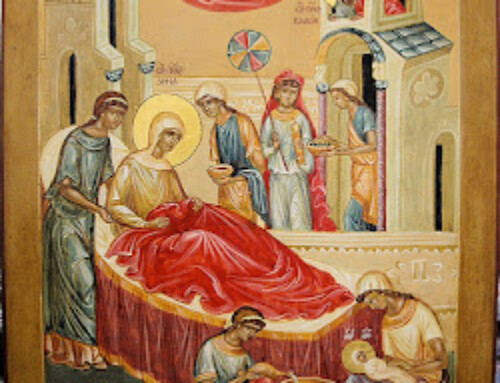January 6
The Feast of Epiphany
Epiphany
by V. Rev. Father Antony Gabriel
Discourse On the Day of the Baptism of Christ
St John Chrysostom
Why Do We Have Our Homes Blessed?
by Phylis Meshel Onest
On January 6, the Holy Orthodox Church celebrates the
Feast of the Epiphany of Our Lord
In the Orthodox calendar the feast of the Epiphany is called ‘Theofania’, the manifestation of God. Epiphany is the most ancient feast, after Easter, relating to the Lord and is observed by the entire Christian Church on January 6. The first evidence attesting to the feast of the Epiphany comes from Clement of Alexandria who died about 215. He relates that a Gnostic group observed the Baptism of our Lord on January 6 believing that it was at the time of Baptism that Divinity took the flesh in Christ. The date of January 6 was selected because according to some ancient reckoning the day began to grow longer on that date and so it was celebrated by pagans as the day of victory of light over darkness. In Rome, though, the day of the birth of the Invincible Sun was celebrated on December 25. In both East and West and practically at the same time, these two pagan festivals were replaced by a Christian feast signifying the epiphany (manifestation) ‘of the sun of justice’ and ‘of the true light of the world’. The 25th of December began to be celebrated in Rome as the day of the Epiphany (Nativity), while in the East January 6 remained as the Epiphany day including both the Nativity and Baptism of our Lord. By the end of the 4th century, the 25th of December as the day of the Nativity was adopted in most of the East, and January 6 remained as the feast of our Lord’s Baptism. When the Eastern Epiphany day was introduced in the West, the already celebrated Nativity on December 25th remained as such, and January 6th, although accepted as the day of Baptism, took the character of manifestation of Christ’s Divinity to the pagan world. Hence the Magi, figuratively representing the entire heathen world, were taken to be the recipients of the saving grace of the newly manifested Christ. It is only the Armenian Church in the East that still celebrates the Nativity and Epiphany together on January 6.
The most characteristic feature of the Orthodox day of Epiphany, or Theophania, is the sanctifying of waters by invoking the Spirit that appeared in the form of a dove over Christ at the time of His Baptism. The Orthodox receive sanctified water at the end of the special service of Epiphany and with it sanctify their homes, gardens, and other possessions while some preserve it for the entire year partaking of it at times of illness and other personal or family adversities. The twelve days between the Nativity of our Lord, December 25th, and the day of the Epiphany, January 6th, is called Dodekaemeron (twelve feastal days) and is considered to be one continuous festive period. On December 26th, the Virgin Mary who gave birth to our Lord is honored, and on January 1, the day of the Circumcision of our Lord is celebrated. The festive character of the period is observed by abolishing all kinds of fasts, apart from the day prior to the Epiphany when the service of the Great Hagiasmos is performed.
There is the Small and Great Hagiasmos, both signifying the liturgical act by which water is sanctified as a result of certain prayers and the invocation of the Holy Spirit, as well as by immersing in it small ceremonial cross. The service is called Hagiasmos sanctification, because it is believed that by being sprinkled with and by drinking this sanctified water the faithful is cleansed and sanctified. The celebrant prays that the sanctified water heal soul and body and protect the faithful against all adversary powers. The use of sanctified water goes back to the ancient Church. Ecclesiastical writers such as Epiphanios and Theodoret mention events involving the use of sanctified water for the purse of restoring health in people and of warding off epidemics and other diseases. Sprinkling with sanctified water (holy water) accompanied by prayers and sealing with the Cross had already been introduced into liturgical use in the 4th century for the purpose of healing not only people but even sick animals, and for bestowing blessing of God on new homes and on new buildings for public use.
Traditionally, on the 1st of each month the priest performed Hagiasmos in church and then visited each home of his parish sanctifying by sprinkling people and their homes with holy water. Naturally, this custom could be observed only in small parishes. In the United States this tradition of monthly Hagiasmos (pronounced in Greek without the H) for the people and their homes is nearly impossible owing to the fact that in very few communities, if any at all, do people reside in a group and in close proximity to the church. Yet most priests perform the monthly Hagiasmos in church and people can take it to their homes that day or on the following Sunday. The Greek term Hagiasmos means both the liturgical service and the sanctified water itself, also known as ‘holy water’. The Great Hagiasmos is performed on Epiphany day, January 6.
Patrinacos, Rev. Nicon D., A Dictionary of Greek Orthodoxy. Pleasantville, N.Y.: Helenic Heritage Publications, 1984. (pp. 160-61; 189-90)

